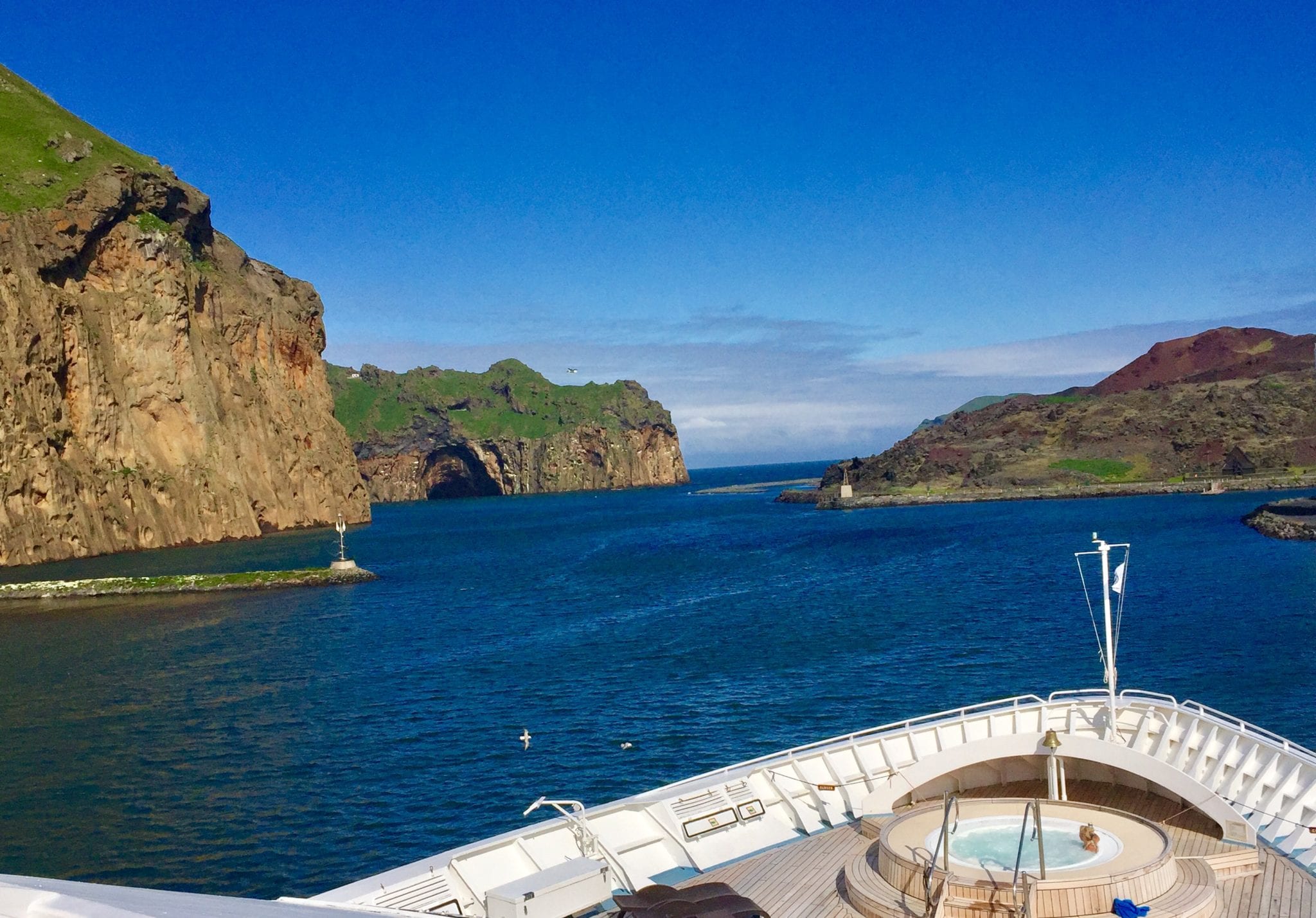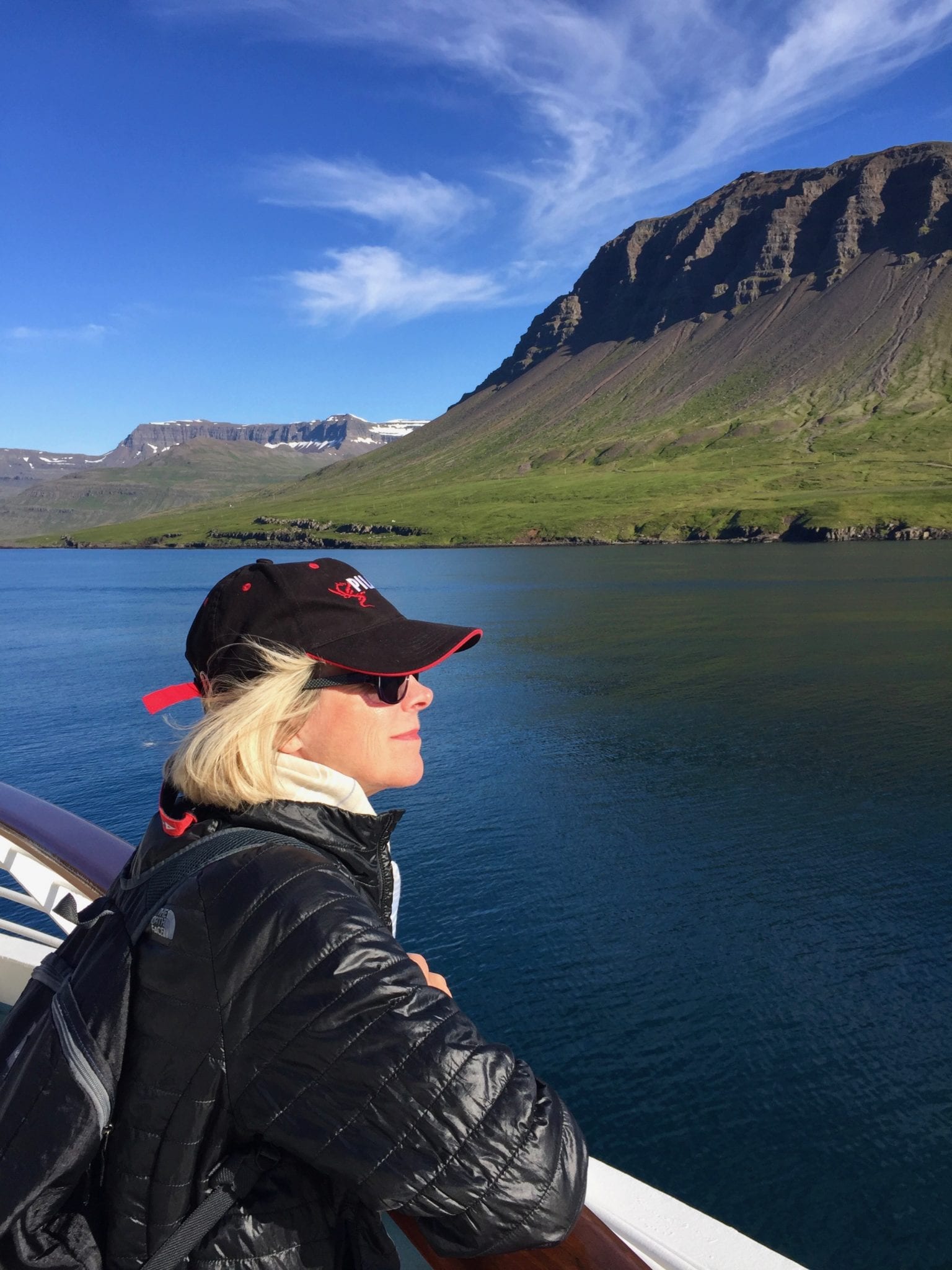Despite its name, only 10% of Iceland is actually covered in ice. In fact, the country about the size of Maine, is gloriously green. Wildflower fields, lush meadows, and rich tundra blanket a landscape of astonishing variety: black sand beaches, tumbling waterfalls, active volcanoes, bubbling hot springs in the middle of the wilderness, and snowcapped mountains.


Two thirds of the island’s 340,000 citizens reside in the capital Reykjavik. The rest live in wind-ravaged fishing villages, small towns and isolated farms. And of course, we wanted to see it all in one trip. Our challenge was to find a comfortable way to visit remote areas of the island without driving mountainous roads and unpacking every night. We honed in on a trip with Windstar Cruises aboard the 208-passenger Star legend for a seven-night cruise to circumnavigate the island.

Beginning and ending our cruise in Reykjavik, our time in the capital was stuffed with things to do, see and experience: we soaked in the Blue Lagoon, slathered ourselves with a white silica mud mask, poked through the Old Harbor neighborhood, ate in seafood restaurants and shopped in small boutiques. At Happy Hour we joined friendly locals at the Beer Garden in the Foss Hotel. “After work, my favorite thing to do is to soak in a thermal pool then meet friends for a beer,” Huggins, our affable guide told us. The abundance of geothermal energy means there is no shortage of naturally heated pools all over the island.
One afternoon in Reykjavik I fulfilled a lifelong dream to ride an Icelandic horse. They are descendants of the original Viking horses and have been part of the landscape for over 1,000 years.

If you are a horse fan, you’ll know why Icelandic four-legged superstars draw attention. They have two extra gaits to offer a besides walk, trot and canter/gallop. A short drive from the city center, we found the champions at the horse farm Islandski Hesturinn. Begga Rist, the owner, explained, “due to the purity of our breed no other horses can enter the country and once a horse leaves Iceland it can never return.” We rode through green fields and volcanic landscapes where I had the most comfortable ride of my life without any lingering soreness.

We left Reykjavik that evening on the Star Legend heading east toward the Westman Islands, an archipelago off the south coast. Our first port of call, the village of Heimaey is known as a “modern-day Pompeii”. In 1973 a volcanic eruption terrorized inhabitants for six months and destroyed 400 homes.
The Eldheimar Museum is built over a home that was destroyed during the eruption. In a dramatic documentary, survivors describe the terror of the eruption, their battle to save the port and their evacuation.
Arctic terns skimmed the water’s surface as we cruised up the east coast past Vatnajökull, the largest glacier in Europe. Cuddled under fleece blankets on the deck, we could see massive ice flows spilling into the sea between deep green fjords.
Walking back to the ship we were sidetracked at the Kaffi Lara for the 10:00 pm-11:00 pm “Happy Hour.” Picnic tables on the street and in the garden were packed with tourists slugging back a variety of the 20 Icelandic beers served until closing hour at 3:30 am.
 The next afternoon we set sail north into the ocean that seemed to go on forever. The evening was clear and calm when we joined the Captain and First Mate in the Bridge. The command station of the ship is often open for visits. A few minutes before midnight as the sun slowly slipped into the North Atlantic, three dolphins surfaced to bid us goodnight, A few minutes later the Captain announced we were crossing the Arctic Circle, at 66-degrees north latitude. This far north the sun sets around midnight and rises at about 3:00 am. Every night we closed the double blackout curtains in our stateroom to shut out daylight.
The next afternoon we set sail north into the ocean that seemed to go on forever. The evening was clear and calm when we joined the Captain and First Mate in the Bridge. The command station of the ship is often open for visits. A few minutes before midnight as the sun slowly slipped into the North Atlantic, three dolphins surfaced to bid us goodnight, A few minutes later the Captain announced we were crossing the Arctic Circle, at 66-degrees north latitude. This far north the sun sets around midnight and rises at about 3:00 am. Every night we closed the double blackout curtains in our stateroom to shut out daylight.
Seydisfjordur, a village of brightly colored timber houses with 700 inhabitants lies at the end of a deep fjord. We hiked to several waterfalls while others went bird watching in nearby Skalanes Nature Reserve, a remote spot even for most Icelanders.
That evening we followed a rainbow path to a small wooden church painted in pastel blue on the outside with shades of pale blue in the interior. Even the large cross over the altar is blue. After a lively concert of local musicians organized by Windstar, a storyteller regaled us with fearsome folktales of trolls and “hidden people”.

After the concert, we strolled to the Technology Museum for a reception where we drank Viking Gylltur, a delicious lager beer, sampled reindeer capriccio and sushi of salmon, char and trout, fresh off the fisher’s boats.
Another day we kayaked to the end of a green fjord beneath snow-capped mountains near the village of Isafjordur. And we jumped at the chance to descend deep into a volcano, to explore caves in an 8,000-year-old lava tube on the Snaefellsness Peninsula.


After a week in Iceland, we understand why it is a hot tourist destination – with visitor numbers increasing 40% a year. The boom is fueled by the country’s spectacular natural beauty and easy access from the East Coast (5 hours from New York or Boston) and Europe (2 ½ hours from Dublin). And many travelers take advantage of attractive airline promotions such as Iceland Air’s “free stopover” of up to seven days on their flights to Europe.
INSIDER TIPS
Look no further than the brewpub and the public pools to meet local residents. The abundance of geothermal energy in Iceland means there is no shortage of naturally heated pools for a dip and conversation.
Iceland is in the middle of a beer revolution, with seasonal, adventurous beers from local breweries hitting the market almost every month.
Find the best sushi on the island at Nord Austur Sushi Bar in Seyðisfjörður, a fishing village and artist community in east Iceland. Local fishermen provide the sushi chefs with their daily catch from the sea, lakes and rivers.
Leave your bug repellant at home and don’t worry if you’re scared of snakes. Iceland has no mosquitoes, bats or reptiles.
IF YOU HAVE AN IRON STOMACH
Local delicacies include warm puffin heart and fermented whale with a chaser of vodka.
Marybeth’s article was first published in the Nov. print edition of TravelGirl Magazine.